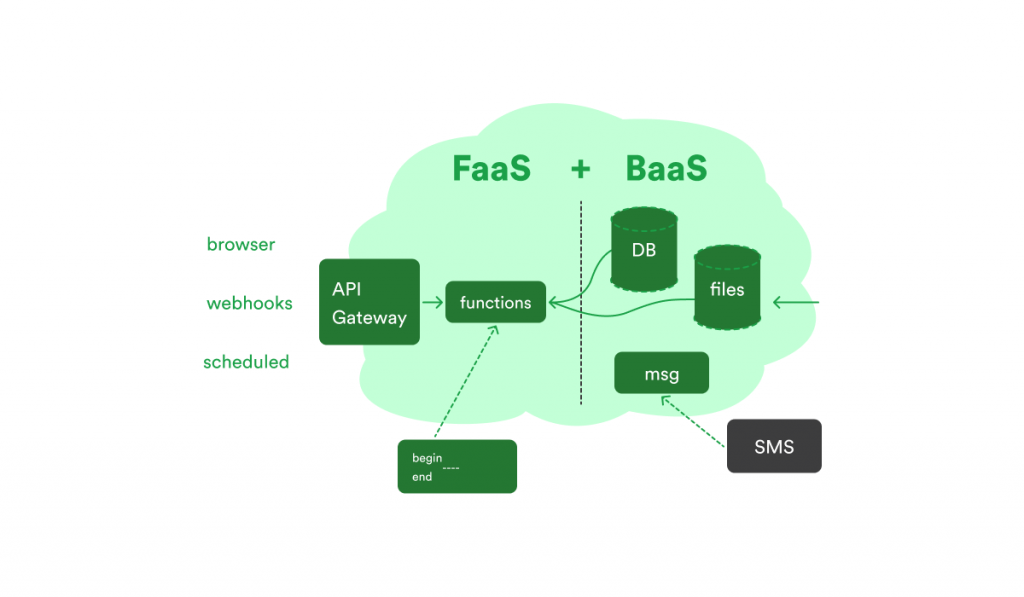
Navigating Cloud Migration: Overcoming Challenges and Maximizing Benefits
Exploring some of the key considerations and challenges in migrating legacy applications to the cloud and sharing practical strategies for a successful transition.
Fast-forward to today, and we have FaaS or Function-as-a-Service, an approach that’s quickly growing into a go-to solution for Cloud developers.
This article will explore the benefits of FaaS for development, deployment and management of microservices applications in the Cloud.
Function-as-a-Service is a type of cloud computing service designed to help developers build, compute, run, and manage various application packages as functions without maintaining their own infrastructure.
As such, you could say that FaaS is an event-driven execution model running on stateless containers. In this scenario, you can manage different functions through server-side logic and state.
What does that mean? Let’s take a step back.
To put it simply, FaaS allows developers to run code in response to events. They can do this without handling all the infrastructure challenges common to creating and launching microservices applications.
As the idea was built on the foundation of serverless computing technologies and architectures, development teams can quickly deploy cloud applications without ever managing servers.
FaaS solutions are freely available across major public cloud services. In this scenario, the cloud services provider will manage the hardware, virtual machine operating system, and web server software.
You can also provision FaaS on-premises, adding robust new capabilities to enterprise IT app development. As the service provider provides the infrastructure, no infrastructure management is needed.
You can develop functions in insolation inside containers. This approach gives development teams total freedom to concentrate entirely on specific functions in the application code.
To put it simply, FaaS allows developers to acquire backend services for cloud applications. You can divide your functions and trigger them during different events. These functions and the event source can be uploaded to the cloud services provider’s FaaS platform.
Although FaaS and serverless computing are often confused, they are not the same thing. In fact, FaaS is essentially a subset of serverless computing.
The serverless approach concentrates on any service category where end-user configuration, management, and payment are transparent. This includes server compute, database, storage, messaging, API gateways, and more.
In contrast, FaaS focuses on an event-driven computing model. In this case, application code, or containers, only run in response to events or requests. More often than not, it’s also the most central technology in serverless architectures.
When a company wants to take advantage of FaaS, they must first partner with a cloud services provider that offers FaaS. This is because developers have nothing to do with application server management in the FaaS delivery model.
The cloud services provider will host and allocate them dynamically based on user demands. For example, software developers can deploy functions in little chunks of code that will run on demand.
Serverless architecture is only active on a dedicated server while the function is being utilized. So, we can quickly shut down functions after it has completed an assigned task. This approach helps free up computing resources that we can devote to other tasks.
Developers like to use FaaS to perform application logic on-demand while the cloud vendor secures and coordinates all application resources. As the FaaS design is simple at best, it’s ideal for repetitive services (like scheduling routine tasks), processing queues, or processing web requests.

NodeJS engine for Cloud FaaS Platforms
What drives most businesses to adopt FaaS is the elimination of on-premise server costs. But there’s much more to it.
As mentioned above, FaaS is cost-effective as you only pay for the services you use. You don’t have to pay in advance for a specified bandwidth quantity, which could go to waste.
FaaS optimizes iterative development protocols.
This allows development teams to build and deploy applications much faster. They can also quickly make changes and adapt to user demand.
If the FaaS provider runs your application close to end-users, it can significantly improve performance and user experiences.
FaaS can ensure high availability. When businesses use leading cloud services providers, they can deploy their applications across geographical locations without incurring additional costs.
FaaS solutions are usually language agonistic. So, developers can code in popular programming languages. There is also no requirement for additional programming knowledge for implementation.
As cloud services providers host FaaS platforms on the cloud, you can scale automatically in response to user demand.
As the cloud vendor will handle scaling, the development team just has to focus on the application.
You can only upload your complete application at once or each function one at a time with FaaS. Similar to microservices, FaaS also allows you to develop backend code for independent functions.
Like anything in life, FaaS also has some drawbacks to consider.
Sometimes, there can be a delay in function execution. Although this doesn’t take longer than a few seconds, it can be problematic for some applications.
As the cloud services provider will manage the infrastructure, developers can only work with predefined systems. If developers find this approach too restricting, there’s good news in the form of Backend as a Service (BaaS).
Application developers can only secure the code they write. For everything else, they have to depend on the cloud vendor. Most often, developers don’t have the necessary visibility to know how the cloud services provider is controlling the usage and storage of certain data types.
Sometimes it’s also challenging to set up a testing environment. More often than not, the transfer of FaaS code to a local test environment tends to become an enormous headache. In this case, application testing might require more resources to complete.
As enterprise applications are developed on top of the FaaS platform, businesses probably get stuck with your cloud vendor. Because of the vendor’s unique cloud and serverless architecture, companies may find that they don’t really have any other option but to stay with their current cloud services provider.
The Intel® Optane™ memory software suite supports the configuration and enables system acceleration with Intel® Optane™ memory.
This technology allows data center operators to optimize the total cost of ownership (TCO) by increasing density of running cloud functions and to minimize the storage latency.
As an Intel Software Partner, our team collaborates closely with Intel US and China teams on FaaS platform optimization.
In one of our recent R&D projects, we had to integrate Intel Optane and Intel RDT technologies to increase performance of the client’s private FaaS frameworks. On top of that, we had to optimize FaaS based on Intel Optane technology.
As a solution, we assembled a 4-person team that:
As a result, we helped the Client:
if you’re looking to migrate enterprise cloud applications quickly and cost-effectively, FaaS can make the process painless. This is because, at the end of the day, it’s all down to you and your cloud environment.
If the workflow fits, it can be a huge advantage going forward. So, FaaS is definitely something you should consider in 2022.

Exploring some of the key considerations and challenges in migrating legacy applications to the cloud and sharing practical strategies for a successful transition.

This article offers organizations a comprehensive guide to navigating the complexities of transitioning legacy applications to cloud infrastructure.

Delving into the essence of successfully implementing ML projects, exploring strategic approaches, the comprehensive life cycle from conception to deployment, and real-world industry applications.
Copyright © 2023 rinf.tech. All Rights Reserved.
Terms & Conditions. Cookie Policy. Privacy Policy.
Politica Avertizari de Integritate (RO)